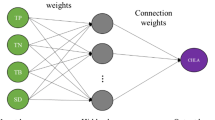Abstract
A fuzzy logic model is developed to estimate pseudo steady state chlorophyll-a concentrations in a very large and deep dam reservoir, namely Keban Dam Reservoir, which is also highly spatial and temporal variable. The estimation power of the developed fuzzy logic model was tested by comparing its performance with that from the classical multiple regression model. The data include chlorophyll-a concentrations in Keban lake as a response variable, as well as several water quality variables such as PO4 phosphorus, NO3 nitrogen, alkalinity, suspended solids concentration, pH, water temperature, electrical conductivity, dissolved oxygen concentration and Secchi depth as independent environmental variables. Because of the complex nature of the studied water body, as well as non-significant functional relationships among the water quality variables to the chlorophyll-a concentration, an initial analysis is conducted to select the most important variables that can be used in estimating the chlorophyll-a concentrations within the studied water body. Following the outcomes from this initial analysis, the fuzzy logic model is developed to estimate the chlorophyll-a concentrations and the advantages of this new model is demonstrated in model fitting over the traditional multiple regression method.
Similar content being viewed by others
References
S.C. Chapra, Surface Water Quality Modeling (Mc-Graw Hill Int. 1997).
P.J. Dillon and F.H. Rigler, The phosphorous-chlorophyll relationship for lakes, Limnol. Oceanog. 19 (1974) 67-773.
W. Rast and G.F. Lee, Summary analysis of the North American (US portion) OECD Eutrophication Project: nutrient loading-lake response relationship and trophic state indices, in: Environmental Research Series, No: EPA-600/3-78-008 (US EPA, ERL, OR, USA, 1978).
A.F. Bartsch and J.H. Gakstatter, Management decisions for lake systems on a survey of trophic status, limiting nutrients and nutrient loadings, in: American-Soviet Symposium on Use of Mathematical Models to Optimize Water Quality Management (U.S. EPA Office of Research and Development, ERL, Gulf Breeze, FL, 1978) pp. 372-394, EPA-600/9-78-024.
W. Rast, R.A. Jones and G.F. Lee, Predictive capability of US. OECD phosphorus loading-eutrophication response models, J. Water Pollut. Cont. Fed. 55 (1983) 990-1003.
CE-QUAL-R1, A numerical one-dimensional model of reservoir water quality; user's manual, instruction report E-82-1 (Revised edition), U.S. Army Engineer Waterways Experiment Station, Vicksburg, MS (1986).
CE-QUAL-W2, A numerical two-dimensional, laterally averaged model of hydrodynamics and water quality; user's manual, instruction report E-86-5, U.S. Army Engineer Waterways Experiment Station, Vicksburg, MS (1986).
M. Scardi, Artificial neural networks as empirical models for estimating phytoplankton production, Mar. Ecol. Ser. 139 (1996) 289-299.
F. Recknagel, M. French, P. Harkonen and K.Yabunaka, Artificial neural network approach for modelling and prediction of algal blooms, Ecol. Mod. 96 (1997) 11-28.
K. Yabunaka, M. Hosomi and A. Murakami, Novel application of a back-propagation artificial neural network model formulated to predict algal bloom, Wat. Res. 36 (1997) 89-97.
C. Karul, S. Soyupak and C. Yurteri, Neural network models as a management tool in lakes, Hydrobiologia 408/409 (1999) 139-144.
B. Kosko, Fuzzy systems as universal approximators, in: IEEE Trans. Comput. Proceedings of the 1992 IEEE Conference on Fuzzy Systems (FUZZ-92) (San Diego, CA, 1992) pp. 1153-1162.
S. Soyupak, C.F. Gökçay, S. Yerli, S. Erdem, N. Akbay and A.F. Çilesiz, Assessment of eutrophication for Keban Dam Reservoir, Fres. Env. Bull. 3 (1994) 181-186.
S. Soyupak, D. Yemişen, L. Mukhallalati, S. Erdem, N. Akbay and S. Yerli, The spatial and temporal variability of limnological properties of a very large and deep reservoir, Journal of Int. Rev. of Hydrobiology 83 (1999) 183-190.
S. Soyupak, Keban Baraj Gölü ve Havzası Çevre Sorunları Projesi, TUBİITAK-DEBAG 1/G Raporu, Ankara, Turkey (in Turkish) (1992).
S. Soyupak, Keban Baraj Gölü ve Havzası Çevre Sorunları Projesi, TUBİITAK-DEBAG 83/G Raporu, Ankara, Turkey (in Turkish) (1993).
C. Karul, Development of an artificial neural network model for the estimation of Chl-a in lakes, METU Department of Environmental Engineering, PhD Thesis, Ankara, Turkey (1999).
T. Takagi and M. Sugeno, Derivation of fuzzy control rules from human operator's control actions, in: Proceedings of the IFAC Symposium on Fuzzy Information, Knowledge Representation and Decision Analysis (1983) pp. 55-60.
H. Bandemer and S. Gottwald, Fuzzy Sets, Fuzzy Logic, Fuzzy Methods with Applications (John Wiley & Sons, 1995).
C.C. Lee, Fuzzy logic in control systems: fuzzy logic controller, IEEE Transactions on Systems, Man, and Cybernetics 20(2) (1990) 419-435.
D.G. Chen, B. Hargreaves, D.M. Ware and Y. Liu, A fuzzy logic model with genetic algorithms for analyzing fish stock-recruitment relationships, Can. J. Fish. Aquat. Sci. 57 (2000) 1878-1887.
N.R. Draper and H. Smith, Applied Regression Analysis, 2nd edn (John Wiley & Sons Inc., New York, 1981).
J.G. Kalbfleisch, Probability and Statistical Inference, Vol. 2: Statistical Inference, 2nd edn (Springer-Verlag, New York, 1985).
Author information
Authors and Affiliations
Rights and permissions
About this article
Cite this article
Soyupak, S., Chen, DG.(. Fuzzy Logic Model to Estimate Seasonal Pseudo Steady State Chlorophyll-A Concentrations in Reservoirs. Environmental Modeling & Assessment 9, 51–59 (2004). https://doi.org/10.1023/B:ENMO.0000020890.57185.92
Issue Date:
DOI: https://doi.org/10.1023/B:ENMO.0000020890.57185.92




